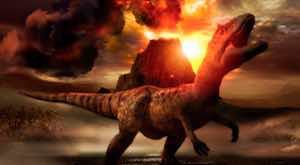The scientists proposed that when the giant asteroid hit Earth, its impact sent such violent tremors through the planet's crust that it set off a wave of volcanic eruptions half a world away. Specifically, they argue that the impact likely triggered most of the immense eruptions of lava in India—that indeed, this was not a coincidence, but a cause-and-effect relationship. These eruptions, known as flood basalts, “were among the largest in the history of the planet, and would have buried all of California a mile deep in lava,” said UC Berkeley geologist Mark Richards. (2)
Both the asteroid and volcanic eruptions could have raised such immense plumes of toxic gases that they would have darkened Earth, lowered global temperatures, and made it impossible for most life to exist.
In our recent times, the impact of volcanic eruptions on global warming could provide a new explanation for the so-called 'pause' in climate change. According to a recent study, models for predicting the rate at which temperatures around the world would rise from 1998 onwards did not take into consideration the measurable impact volcanoes can have. Rather than contributing to global warming, eruptions release particles into the air that reflect sunlight—causing temperatures to drop. This phenomenon was not taken into account when predictions were made—offering an explanation for why the world seemed to stop heating up. (3)
One example: The eruption of Mount Pinatubo in the Philippines on June 15, 1991, was one of the largest eruptions of the 20th century. Sulfur aerosol formed in the stratosphere from sulfur dioxide in the Pinatubo cloud increased the reflection of radiation from the Sun back into space. Consequently, the Earth's surface cooled in the three years following the eruption by as much as 1.3 degrees F at the height of the effect. (4)
One myth is that volcanoes emit more CO2 than human activities. According to the USGS, research findings indicated that the answer to this is a clear and unequivocal 'no'. Human activities, responsible for a projected 35 billion metric tons (gigatons) of CO2 emissions in 2010, release an amount of CO2 that dwarfs the annual CO2 emissions of all the world's degassing subaerial and submarine volcanoes. The published estimates of the global CO2 emission rate for all degassing subaerial (on land) and submarine volcanoes lie in a range from 0.13 gigaton to 0.44 gigaton per year. The 35 gigaton projected anthropogenic CO2 emissions for 2010 are about 80 to 270 times larger than the respective maximum and minimum annual global volcanic CO2 emission estimates. (5)
In spite of this it is clear that volcanoes have a definite influence on climate. But besides this they offer threats to folks in many populated areas of the world. Around 60 volcanoes erupt in the average year. On any particular day, there are usually about 20 volcanoes erupting somewhere in the world. (6) In the US alone, there are almost 70 active volcanoes.
Nyiragongo, one of the most active volcanoes on the planet, is a two-mile high volcano towering over the eastern edge of the Democratic Republic of Congo. A lava lake 700 feet across, which is part of Nyiragongo, every day emits around 7,000 tons of sulfur dioxide, the chief element in acid rain. This is more than the total from every car and factory in the United States. (7)
Alan Caruba
adds, “What Americans need to worry about is the eruption of a super volcano with a large caldera such as the Yellowstone Caldera in Yellowstone National Park and the Valles Caldera in New Mexico. Both have been dormant for thousands of years.” (8)
Jack Dini
Livermore, CA
References
1.
Mark A Richards et al., “Triggering of the largest Deccan eruptions by the Chicxulub impact,” April 30, 2015,
2. David Perlman, “Dual disasters may be behind dinosaur doom,” San Francisco Chronicle, May 3, 2015
3. Benjamin D. Santer et al., “Volcanic contribution to decadal changes in tropospheric temperature,” Nature Geoscience, 7, 185, 2014
4. Kenneth A. McGee et al., “Impacts of volcanic gases on climate, the environment, and people,”
pubs.usgs.gove, May 1997
5. “Volcanic gases and climate change,” volcanoes.usgs.gov, accessed may 7, 2015
6. David Rothery, “The environmental disaster you haven't heard of,”
realclearscience.com, December 12, 2014
7. Michael Finkel, “Volcano next door?”, National Geographic, 219, 82, April 2011
8. Alan Caruba, “The world's volcanic past and future,”
factsandfantasy.blogspot.com, February 20, 2014
 About 65 million years ago an object about 10 km (6 miles) across impacted the Earth in the Yucatan. The most accepted theory is that this event ended the Cretaceous Period and wiped out the dinosaurs.
However, debate over what killed the dinosaurs is heating up anew as a team of UC Berkeley scientists suggests that this asteroid slamming into the Earth must have triggered the eruptions of thousands of volcanoes on the other side of the planet—a combined event that could have helped to doom the beasts. (1)
About 65 million years ago an object about 10 km (6 miles) across impacted the Earth in the Yucatan. The most accepted theory is that this event ended the Cretaceous Period and wiped out the dinosaurs.
However, debate over what killed the dinosaurs is heating up anew as a team of UC Berkeley scientists suggests that this asteroid slamming into the Earth must have triggered the eruptions of thousands of volcanoes on the other side of the planet—a combined event that could have helped to doom the beasts. (1)